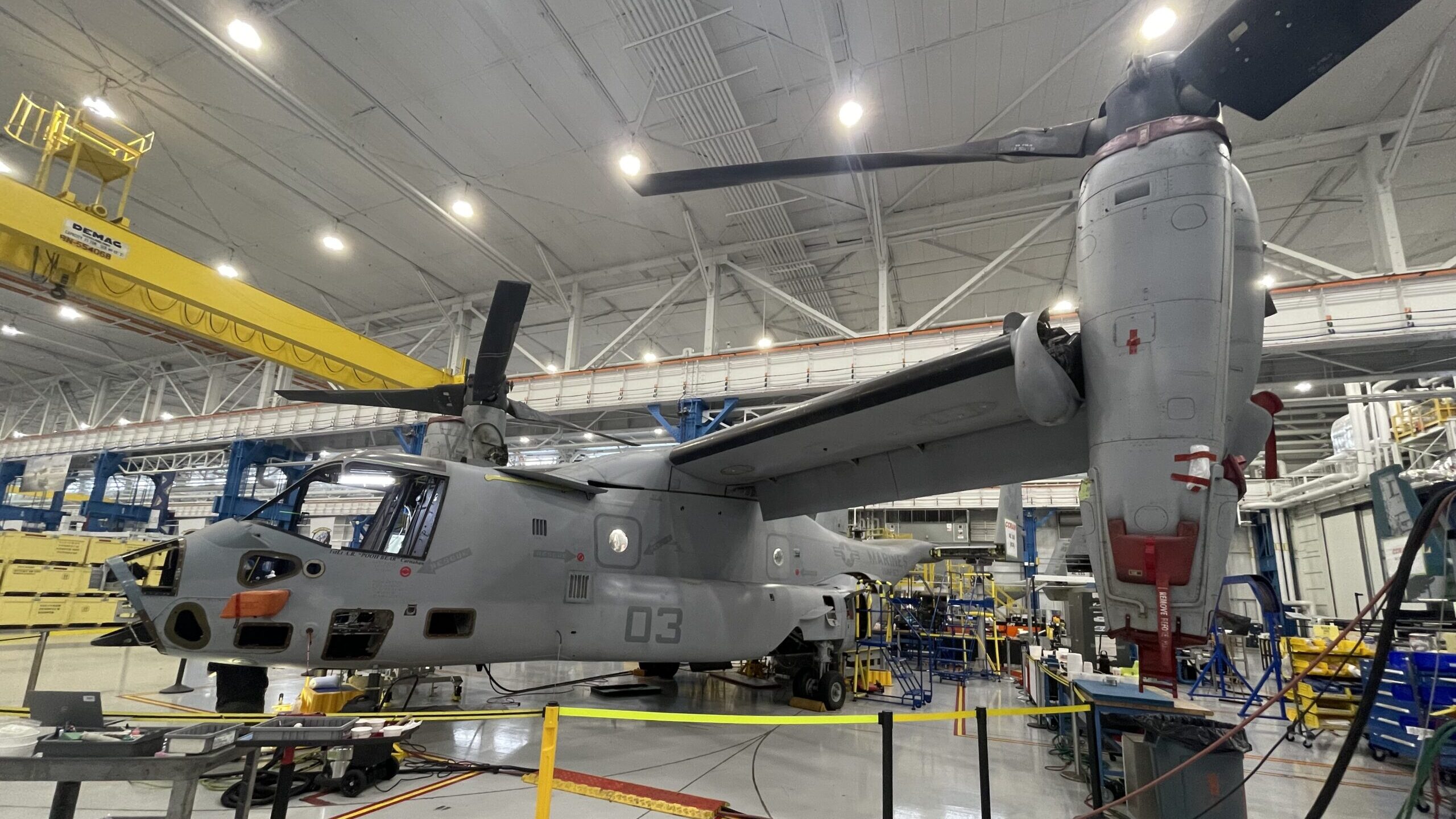
An MV-22 Osprey for the Marines Corps undergoes an upgrade along Boeing’s production line in Philadelphia. (Michael Marrow/Breaking Defense)
PHILADELPHIA — A retrofit effort to return an undisclosed number of grounded Bell-Boeing V-22 Ospreys to flight is over halfway complete, the aircraft’s Joint Program Office tells Breaking Defense — and yet, the root cause of a so-called “hard clutch engagement” (HCE) issue remains elusive.
“The joint V-22 team, government and industry, have made significant progress to replace input quill assemblies affected by the February flight limitations. To date, more than half of the affected aircraft have returned to flight and we expect to finish the replacements this fall, ahead of schedule,” a spokesperson for the office said.
“Our progress to date has resulted in a safer V-22 fleet, better understanding of the HCE phenomenon, and a redesigned clutch in work that will greatly reduce or eliminate HCE risks in the future,” the office continued. “Our investigations have led to several new findings which have significantly improved our understanding of the HCE phenomenon. While definitive root cause for all HCE events has not yet been pinned down, we are applying this new information to generate and implement solutions to reduce the likelihood of an event, and are included in the redesigned clutch.”
In February, the Pentagon barred an unclear number of the tiltrotors from flying until each were able to replace their input quill assembly (IQA), which connects an engine to its drive system. Replacing the IQA mitigates the issue with the aircraft’s clutch, where power can rapidly shift between the tiltrotor’s two engines and force aircrews to land immediately if the clutch slips.
The requirement to replace the IQA applies to V-22s with a certain number of flight hours, though the Pentagon has not disclosed the threshold or said how many Ospreys have ultimately been impacted by the issue.
Speaking to reporters on Tuesday at Boeing’s facilities on the outskirts of Philadelphia, where the Osprey’s fuselage is fused together before being shipped to Bell for final assembly, Boeing’s vice president for tiltrotor programs Shane Openshaw said “the process of putting the appropriate fix onto the effected aircraft within the fleet is well underway. And the customer is satisfied with the progress that’s being made.
“We’re replacing all the input quills that are in excess of that time,” he continued, before acknowledging that the root cause of what’s wearing out the quill assembly is still not fully understood. (Like other media, Breaking Defense accepted accommodations from Boeing for the visit.)
Besides the IQA replacements, the V-22 program is pursuing other mitigation efforts, its joint program office said, such as a roughly $13 million contract awarded in January to design a new IQA along with the refreshed clutch. A nearly $54 million contract awarded in March will fund efforts to design a new system that “will alert ground crew of abnormal vibrations in the drive system to mitigate drive system issues, improving availability and safety” and enable condition-based maintenance. Integration of the new system is slated for fiscal 2025, the office stated.
A spokesperson for Bell deferred questions to the program office but added “The V-22 community share a common commitment to safety of aircrew. We work to identify the HCE root cause and implement corrective measures to enhance aircraft and aircrew safety.”
The Air Force, Marines and Navy each fly variants of the Osprey, as well as the Japanese military. In March, a US official told Breaking Defense that the Japanese Ospreys are young enough that they have not needed to be retrofitted with the new parts, but acknowledged that they may need the fix in the future.
Walking along its production line, Openshaw explained that the V-22’s “subtle” differences mainly materialize in different mission equipment for the Air Force, with the Navy’s variant focused mainly on range and fuel capacity. “Other than that, the configurations are pretty common,” he said, while noting that Japan’s variants feature a specialized communications package.
Two Ospreys for the Air Force, 14 for the Marines Corps and 20 for the Navy remain to be delivered, according to a Boeing spokesperson, after which the tiltrotor’s production line is at risk of shutting down.
“We look forward to continuing to pursue additional efforts to keep the production capability going,” Openshaw said.
Northrop sees F-16 IVEWS, IBCS as ‘multibillion dollar’ international sales drivers
In addition, CEO Kathy Warden says the company sees a chance to sell up to five Triton UAVs to the NATO alliance.


























